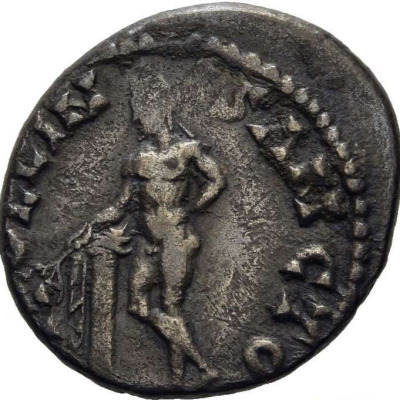Gaius Pescennius Niger appeared in the pages of history in extremely interesting and difficult times for Imperium Romanum. After the murder of Emperor Commodus and the short and at the same time tragic reign of Pertinax, the entire state plunged into a civil war that lasted until 197 CE.
As is well known, its final winner was Septimius Severus, who condemned his opponents to damnatio memoriae. Consequently, most of the surviving literary sources from this period are extremely biased and reflect primarily the Severian propaganda line. Little is written about his opponents, and if anything, most often in a rather unfavourable light. Numismatic sources come to our aid, which, at least to a small extent, reflect the propaganda programs of other participants in the civil war, including the aforementioned Gaius Pescennius Niger.
Like its competitors, Niger had an independent coinage through which it sought to spread its political propaganda. Its main mint was located in Antioch and operated in the years 193-194, but it is difficult to clearly indicate which coins were minted in the first and which in the second year of the mint’s operation. He owned several other, smaller mints in Antioch and Caesarea Germanica, but they did not play a big role. The vast majority of his coins are denarii, and a few aureuses also appear. The usurper’s title was as follows: Imperator Caesar Gaius Pescennius Niger Iustus Augustus. It is very interesting to add Iustus (fair) to the title. It was probably a propaganda effort. After the compromising reign of Commodus, the brutal murder by the praetorians of the honest Emperor Pertinax, and the shameful “auction” of the imperial purple by Didius Julian, the inhabitants of the Empire undoubtedly wanted the return of righteous and stable rule, similar to that of the Antonine dynasty. The nickname Iustus is not only an element of the title, because it also appears as a personified idea, i.e. Justycja. Niger’s greatest political opponent, Septimius Severus, used a completely different line of propaganda. Namely, he included the name Pertinax in his title, this element was intended to emphasize that Severus was the avenger of Pertinax and his rightful successor.
As for the monetary portrait of Niger himself, it should be noted that it contained many elements characteristic of the eastern part of the Empire. On the obverse of the coins, the changeling looked as follows: an oval face with a large nose, huge eyes under a thick eyebrow, hair combed, similar to the portraits of its predecessors, a long, curly beard divided into several strands. It seems that this portrait was quite personalized and undoubtedly to some extent reflected the appearance of Pescennius Niger.
Figures of deities were an extremely popular iconographic element on Roman numismatics. They also appear on Nigra coins, but in small numbers. One of those that the changeling propagated on its coins with particular frequency was Apollo. Through his image, efforts were made to reach the inhabitants of the eastern provinces, among whom the cult of Apollo was very popular.
Other important deities appearing on the coins are Mars and Minerva. Legends placed with their images and attributes of deities clearly indicate that their two main features are emphasized, Mars as the god of war (MARTI VICTORI, MARTI AVGVSTO) and Minerva as the goddess of wisdom and victory (MINER VICT). These are purely Roman monetary iconographies, so Niger tries to clearly emphasize that Roman traditions are extremely important to him.
Another interesting issue of Niger was the one with the representation of the Roman goddess Ceres with a legend (CERERI FRVGIFER). It heralded a new golden age and prosperity in the empire. Interestingly, similar slogans appear in every participant in the civil war of 193-197 CE.
In these difficult times for the Empire, coins often refer to the promise of peace and stability. Such a motive can be, for example, Fortuna. On Nigra coins it appears with the legend FORTVNAE REDVCI. Another example of this type of motifs are numismatic items with legends. FELICIA TEMPORA, SAECVLI FELICITAS.
The coins featured many more of the traditional Roman motifs. The support of Jupiter is emphasized (the legends with the slogan IOVI CONSERVATORI, IOVI PRAE. ORBIS and the idea of Rome’s eternity (ROMAE AETERNAE), as well as the durability of Niger’s rule (AETERNITAS AVGVSTI). It seems that Pescennius Niger is consciously referring to the nickname of Jupiter. conservator, which was previously used in the coinage of emperors such as Domitian and Trajan to commemorate military victories, while the figure of Roma and the personification of aeternitas (eternity) were extremely popular in the times of Emperor Hadrian. Emphasizing the motifs characteristic of the Antonin dynasty was intended to show attachment to traditional Roman virtues, so especially desirable during the civil war.
Like any emperor, Pescennius Niger must have been a victorious leader. In fact, he could hardly boast of many victories on the battlefield. As anything is possible in propaganda, the coins alluded to this extremely popular topic. The changeling boasts, among other things, bravery and bravery through the personification of Virtus. Niger is also presented as a victorious emperor, this feature is emphasized by the legends with the inscription INVICTO IMP. These motifs are also accompanied by references to the goddess of victory, very popular in the times of the Empire, for example the legend: VICTORIA IVST. AVG, VICTORIA (E) AVG. The governor of Syria is also seeking consent from the soldiers, so there are coins with the inscriptions FIDEI EXERCITVI and CONCORDIA (consent).
In summary, Pescennius Niger’s monetary propaganda hardly turned out to be a breakthrough in the long Roman mint tradition. He used well-known and well-established slogans. On the one hand, it can be considered a lack of innovation, and on the other, as a deliberate reference to the ideological programs of its predecessors, in particular to the representatives of the Antonin dynasty. He emphasized his respect for political and religious traditions, which was undoubtedly an element that legitimized his power. The qualities of the candidate for purple were also eagerly propagated. He was brave (Virtus), victorious (Invictus) and just (Iustus) It should also be added that his coins featured typical eastern iconographic representations such as Apollo. This, too, had its ideological overtone. As Niger was the governor of Syria and this was where his recruitment base was, it was necessary to convince the inhabitants of these lands to their cause. As was to be seen in the future, the monetary propaganda of Gaius Pescennius Niger was not enough to defeat Septimius the Server, but it gives us some testimony of his reign that we will not find in other ancient sources.









